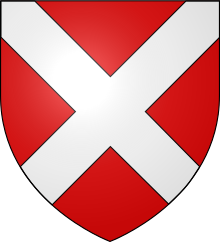



Thomas Nevile (died 1615) was an English clergyman and academic who was Dean of Peterborough (1591–1597) and Dean of Canterbury (1597–1615), Master of Magdalene College, Cambridge (1582–1593), and Master of Trinity College, Cambridge (1593–1615).
Origins
He was born in Canterbury, a son of Richard Neville of South Leverton, Nottinghamshire (who moved to Canterbury in his retirement), a son of Alexander Neville, Escheator of Nottinghamshire and Derbyshire in 1519–20. His mother was Anne Mantell, a daughter of Sir Walter Mantell of Nether Heyford, Northamptonshire. His brother was the scholar Alexander Neville (1544–1614). He bore the same arms as the prominent and ancient Neville family, Earls of Westmorland. The origins of the Neville family of South Leverton are unclear, but an early ancestor was Thomas Neville, Recorder of Nottingham and Member of Parliament for Nottingham in 1472.
Career
He originally came to Cambridge to study at Pembroke. During a long and distinguished career he held a succession of prestigious ecclesiastical posts including the Deanery of both Peterborough and Canterbury, that allowed him to build substantial personal wealth. Within Cambridge, his popularity in the Court of Queen Elizabeth meant he found similar success there, both as Master of Magdalene College and as Vice Chancellor of the university in 1588. Then, in February 1593 Elizabeth appointed him to succeed John Still to the Mastership of Trinity, and it is for his mastership of Trinity that he is now best remembered.
The college he inherited was little more than the architectural remains of the colleges that had united to form Trinity, and he set about using both his personal wealth and influence to create a setting unrivalled in academic England. To quote Trevelyan, "If Henry VIII founded Trinity, Nevile built it".
Over the next decade he razed a number of existing buildings to clear the space for the area now known as Great Court. This included moving Great Gate, the entrance gate to the college, 20 metres east brick by brick, and resulted in one of the largest enclosed courts in Europe.
In his final years he built an additional court, Nevile's Court, paid for entirely by himself.
A monument showing two kneeling effigies representing Thomas and his brother Alexander survives in Canterbury Cathedral.
References
- ^ "Nevill, Thomas (NVL564T)". A Cambridge Alumni Database. University of Cambridge.
- ^ Dictionary of National Biography, 1885-1900, Volume 40, Neville, Thomas (d.1615), by James Bass Mullinger
- ^ "NEVILLE, Sir Anthony (By 1508-57), of South Leverton and Mattersey, Notts. | History of Parliament Online".
- "Dean Nevil – Canterbury Historical and Archaeological Society". Retrieved 22 October 2022.
External links
![]() Media related to Thomas Nevile at Wikimedia Commons
Media related to Thomas Nevile at Wikimedia Commons
- Hutchinson, John (1892). "Thomas Nevile" . Men of Kent and Kentishmen (Subscription ed.). Canterbury: Cross & Jackman. p. 106.
| Academic offices | ||
|---|---|---|
| Preceded byDegory Nicholls | Master of Magdalene College, Cambridge 1582–1593 |
Succeeded byRichard Clayton |
| Preceded byJohn Still | Master of Trinity College, Cambridge 1593–1615 |
Succeeded byJohn Richardson |
| Church of England titles | ||
| Preceded byRichard Fletcher | Dean of Peterborough 1590–1597 |
Succeeded byJohn Palmer |
| Preceded byRichard Rogers | Dean of Canterbury 1597–1615 |
Succeeded byCharles Fotherby |
This Anglicanism-related article is a stub. You can help Misplaced Pages by expanding it. |
- 16th-century births
- 1615 deaths
- Masters of Trinity College, Cambridge
- Alumni of Pembroke College, Cambridge
- Fellows of Magdalene College, Cambridge
- Masters of Magdalene College, Cambridge
- 16th-century English Anglican priests
- 17th-century English Anglican priests
- Deans of Canterbury
- Deans of Peterborough
- Vice-chancellors of the University of Cambridge
- Anglicanism stubs
